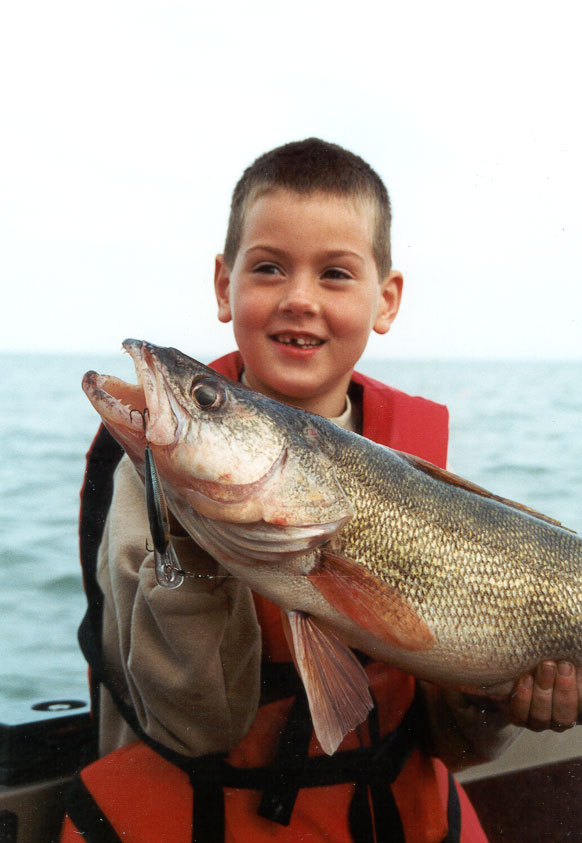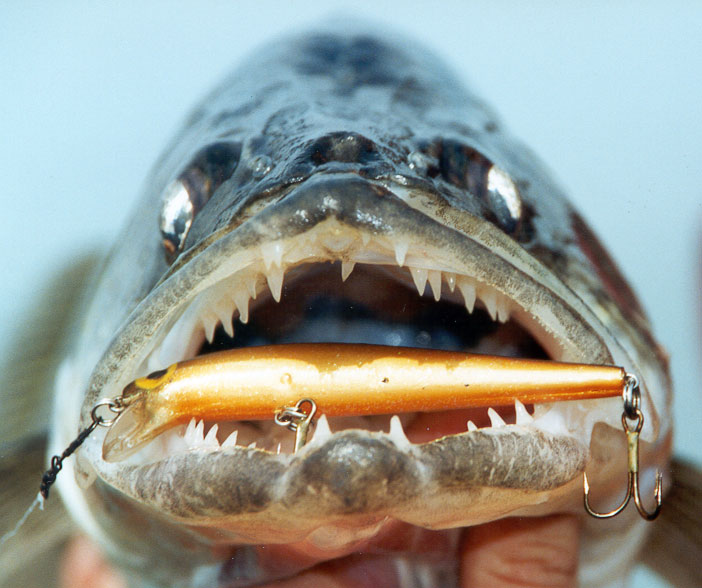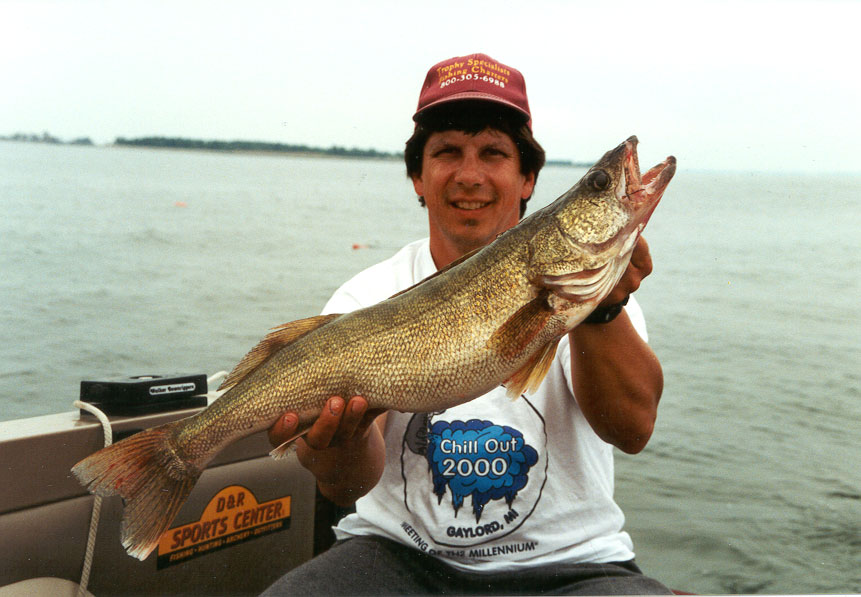ctively feeding on baitfish in preparation for the
riggers of spawning. The Thundersticks did a pretty good job of matching the
hatch.
After setting a nifty spread of six lures trailing behind Mr. Walleye inline
planer boards, the three of us didnít have to wait long before one of the
boards began falling out of formation indicating a strike. I prefer letting the
fish pull the board all the way back before starting the retrieve. This lets the
fish clear the remaining lines and also maintains maximum tension during the
fight resulting in a high bite to catch rate. We all watched in amazement as the
board just kept going and going back until it was all the way back directly
behind the boat.
The angler slowly reeled in line. However, it took over five minutes just to
retrieve the board to my waiting hands so I could detach it. With the somewhat
heavy board removed, youíd think the fight would have gotten easier. Wrong!
Drag still kept slipping and the battle wore on for another five minutes.
Finally, I was able to slide the net under a 10-pounder with flared gills and
the kind of rotund belly that a beer drinking, pizza eater would be proud of. We
went on to catch and mostly release dozens of big walleyes that day and all on
crankbaits.
Itís a fact that some conditions dictate the use of crawlers, minnows,
spoons and other alternative lures. None-the-less crankbait trolling is by far
my most productive walleye fishing tactic on Lake Erie day in and day out. When
the walleyes are cruising in the shallows or when they are suspended over deeper
water, crankbaits are typically deadly medicine. They are even effective when
the fish are scraping their bellies on the bottom.
productive walleye fishing tactic on Lake Erie day in and day out. When
the walleyes are cruising in the shallows or when they are suspended over deeper
water, crankbaits are typically deadly medicine. They are even effective when
the fish are scraping their bellies on the bottom.
Crankbaits attract walleyes mainly by imitating forage. Sometimes it takes
some real imagination, but most effective crankbaits on the market look somewhat
like minnows, shad, gobbies, crayfish or other walleye delicacies. On the other
hand, some hot crankbaits on Erie donít look even remotely like any natural
walleye forage that Iíve ever seen before. These cranks solicit reactionary
strikes, sometimes the only way to open a walleyeís jaws on some days.
Cold Water
When the water temperature holds below 48 degrees, crankbaits with a longer
profile and a stubby diving lip typically get the most bites. Often called
stickbaits or body baits, these cranks are perfect for the slow trolling
presentation necessary to entice walleyes in frigid waters. Lures like Storm
Thundersticks, Normark Original Floating Rapalas, Husky Jerks and
Countdowns along with Reef Runnerís Lilí Ripper and Rip Stick all have
their days. Other good stickbaits include the Bomber Long-A, Smithwick Rattliní
Rouges, Excalibur Minnows, Mystic Minnows, Cotton Cordell Red Fins and Cabalaís
Real Image Floating Minnows. In fact, there are so many good quality, minnow
imitating stickbaits on the market these days that it boggles the mind. During
cold water conditions and especially when the water clarity is poor, dark baits
like black/silver and gold seem to produce the best. Clear water colors run the
spectrum with dark colors still working well on some days; other days dictate
using bright finished baits for best success.
A main factor contributing to walleye success with these lures in cold water
is trolling speed. I typically start trolling stick baits just after ice at less
than .5 miles per hour (mph). At an idle, my 9.9 hp, four-stroke, Mercury
trolling motor barely idles down slow enough. If thereís a wind, then the
deployment of drift socks or the use of an electric motor becomes necessary. On
some occasions I simply drift along using my motor as a rudder to keep things
moving straight and tangle free. The same slow trolling tactics also work well
after the waters cool down during the fall.
Because cold water walleyes often seek out the warmest water they can find,
they often suspend high in the water column or move into the shallows,
especially during the evening on warmer days. This makes the use of planer
boards a must for consistent success. Slow trolling presentations do not lend
themselves well to large, tethered style planer board setups. Instead, inline
boards shine and when fished properly, the hookup to catch ratio can be quite
high. The key to success is to allow the fish to fully pull the board back
before grabbing the rod from its holder. Cold water walleyes and especially the
big ones typically just chomp down on lures holding on without ever realizing
theyíre hooked. When the board is fully pulled back, maximum pressure is
applied to the business end, so when the walleye finally does perform those
stereotypical head-shakes, the hooks are more likely to dig into pay-dirt.
Warming Water
When the water temperature rises above the 48-degree mark, itís often like
a light switch has been flipped on. Walleyes typically switch their feeding
preferences to faster paced offerings. Usually the more lure action the better.
This is when long-lipped, deep diving crankbaits shine with their fast side to
side, vibrating action. The list of productive long-lipped, Lake Erie cranks is
quite extensive to say the least. My all time favorite crankbait on Erie though
is the #7 Normark Shad Rap. Iíve caught thousands of both trophy and eating
sized walleyes on those diminutive Shad Raps and I only use four colors during
the entire season. When the water is cold (below 55 degrees) and the conditions
are muddy, the shad pattern works wonders. Once the water clears up somewhat I
use black/silver during low light periods and chartreuse/silver and fire-tiger
during bright sunny days. Iíve also had considerable success using Storm HotíN
Tots with the 1/4-ounce size being the most productive. The green herring-bone
over chrome is my best HotíN Tot pattern with purple, perch, naturalistic
perch, gold/black and chartreuse/silver all having their days.
season. When the water is cold (below 55 degrees) and the conditions
are muddy, the shad pattern works wonders. Once the water clears up somewhat I
use black/silver during low light periods and chartreuse/silver and fire-tiger
during bright sunny days. Iíve also had considerable success using Storm HotíN
Tots with the 1/4-ounce size being the most productive. The green herring-bone
over chrome is my best HotíN Tot pattern with purple, perch, naturalistic
perch, gold/black and chartreuse/silver all having their days.
Storm Deep Jr. Thundersticks are also some of my most productive Lake Erie
crankbaits. Fire-tiger has been my most productive pattern with
black/silver-scale coming in a close second. Reef Runners are another productive
crankbait and theyíre gaining popularity every year on the Great Lakes and
inland waters. Capt. Rocco Papandrea rates the Reef Runner Lilí Ripper in
chartreuse patterns as his most consistent producers. When walleyes are
aggressively feeding during the summer, many anglers favor tiny crankbaits like
Wiggle-Warts or Wee-Warts. Iíve also had good luck taking smaller walleyes
with the 1/3-ounce Cotton Cordell CC-Shads in bright colors.
Depth Control
Crankbaits are versatile baits that can target walleyes in all levels of the
water column. There are four factors that affect how deep a trolled lure will
run: Lure design, boat speed, line diameter and the set-back all contribute to
running depth. For all my crankbait fishing, I always use 10-lbs. test,
monofilament line. This provides a consistent line diameter for precise lure
running control. I also use Daiwa Line Counter reels to measure the setback for
repeating previously productive programs.
Most savvy charter captains and pro anglers rely on a book titled
"Precision Trolling" created by Steve Holt, Tom Erwin and Mark
Romanack. These three skilled and noted authors are also seasoned walleye pros.
This book provides dive curve data for most of the popular crankbaits on the
market today. Using the dive curves, itís a simple matter to hit a specific
running depth by simply measuring out the proper setback and then controlling
the trolling speed. This valuable book can be purchased by phoning 231-829-3344.
The book even comes laminated for long lasting endurance.
Adding weight is a surefire way to achieve deeper running depths with
crankbaits. I religiously use rubber core sinkers during most of my crankbait
fishing applications. Adding rubber core sinkers makes setting lines faster by
shortening the setbacks; an important factor when trying to run lots of lines. A
shorter setback also results in less line stretch and a better hookup ratio. Youíll
also experience fewer tangles using sinkers as they catch debris, preventing
lures from fouling. They also help baits to track straighter. Removable weights
like Off-Shore Snap Weights or Church Tackle Supper Clips are another great
method for taking baits deeper without interfering with lure action or spooking
fish.
Fine Tuning
A crankbait is only effective if it runs true. Landing fish is the
biggest culprit in knocking baits out of tune. This can easily be corrected by
bending the eyelet or the wire connecting link in the opposite direction that
the lure is tracking. This process may take some trial and error. I check the
tune on my baits every time I set use them by first inspecting their running
characteristics alongside the boat before letting them back.
Dull hooks are perhaps the single leading cause of lost fish when crankbait
trolling. Walleyes and especially those huge trophies have bony mouths that defy
all but the sharpest hooks from taking hold. I hone my hooks to a sticky sharp
point using a sharpening stone specifically designed for the task. When a
walleye hits a trolled crankbait, the hookset usually occurs when the walleye
shakes his head soon after realizing heís been had. Knowing this makes sharp
hooks especially important for successful trolling. If you have any questions,
[email protected] is my email address.
 productive walleye fishing tactic on Lake Erie day in and day out. When
the walleyes are cruising in the shallows or when they are suspended over deeper
water, crankbaits are typically deadly medicine. They are even effective when
the fish are scraping their bellies on the bottom.
productive walleye fishing tactic on Lake Erie day in and day out. When
the walleyes are cruising in the shallows or when they are suspended over deeper
water, crankbaits are typically deadly medicine. They are even effective when
the fish are scraping their bellies on the bottom. same kind of action on their trip. After all, the
weather had been fair for 10 days in a row and the water was crystal clear.
Perfect pre-spawn walleye conditions.
same kind of action on their trip. After all, the
weather had been fair for 10 days in a row and the water was crystal clear.
Perfect pre-spawn walleye conditions.
 season. When the water is cold (below 55 degrees) and the conditions
are muddy, the shad pattern works wonders. Once the water clears up somewhat I
use black/silver during low light periods and chartreuse/silver and fire-tiger
during bright sunny days. Iíve also had considerable success using Storm HotíN
Tots with the 1/4-ounce size being the most productive. The green herring-bone
over chrome is my best HotíN Tot pattern with purple, perch, naturalistic
perch, gold/black and chartreuse/silver all having their days.
season. When the water is cold (below 55 degrees) and the conditions
are muddy, the shad pattern works wonders. Once the water clears up somewhat I
use black/silver during low light periods and chartreuse/silver and fire-tiger
during bright sunny days. Iíve also had considerable success using Storm HotíN
Tots with the 1/4-ounce size being the most productive. The green herring-bone
over chrome is my best HotíN Tot pattern with purple, perch, naturalistic
perch, gold/black and chartreuse/silver all having their days.